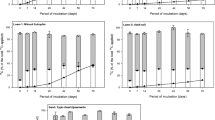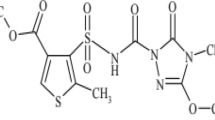Abstract
Fate of thiodicarb and its major metabolite in sandy loam soil were studied by applying thiodicarb (Larvin 75 WP) at 500 and 1000 g a. i. ha−1 under laboratory conditions. Samples drawn periodically were analysed on GC-FTD equipped with capillary column. The average initial deposits of total thiodicarb (thiodicarb and methomyl) were 0.025 and 0.035 mg kg−1 at single and double dosages, respectively. Residues of thiodicarb reached below the determination level (BDL) of 0.005 mg kg−1 after 15 days. Half-life periods for total thiodicarb were calculated to be 5.90 and 8.29 days at two doses, respectively, following first-order kinetics.


Similar content being viewed by others
References
Boesten, J. J. T. I., & Van der Linden, A. M. A. (1991). Modelling the influence of sorption and transformation on pesticide leaching and persistence. Journal of Environmental Quality, 20, 425–435.
Brown, C. D., Hart, A., Lewis, K. A., & Dubus, I. G. (2003). Simulating the environmental fate of pesticides for a farm-level risk assessment system. Agronomie, 23, 67–74.
Chandra, R., Srivastava, A., & Srivastava, P. C. (2009). Fate of benfuracarb insecticide in mollisols and brinjal crop. Bulletin of Environmental Contamination and Toxicology, 83(3), 348–351.
Chopra, I., Chauhan, R., & Kumari, B. (2013). Dissipation and persistence of thiodicarb in cotton. International Journal of Agricultural Science and Technology (IJAST), 1(2), 28–31.
Summary of the EFSA Scientific Report (2005). Conclusion regarding the peer review of the pesticide risk assessment of the active substancethiodicarb 55, 1–76.
Dyson, J. S., Beulke, S., Brown, C. D., & Lane, M. C. G. (2002). Adsorption and degradation of the weak acid mesotrione in soil and environmental fate implications. Journal of Environmental Quality, 31, 613–618.
Hoskins, W. M. (1961). Mathematical treatment of loss of pesticide residues. FAO Plant Protection Bulletin, 9, 163–168.
Jones, R. L., Hunt, T. W., Norris, F. A., & Harden, C. F. (1989). Field research studies on the movement and degradation of thiodicarb and its metabolite methomyl. Journal of Contaminant Hydrology, 4, 359–371.
Khosawinah, A. M. & College, P. R. (1978). Fats of single oral dose of C14-acetyl UC51762 in a lactating cow metabolism into natural products. Unpublished report No UCC 814 C21, submitted to WHO by research triangle park, North Carolina, USA.
Levitan, L. (1997). An overviewof pesticide impact and risk assessment systems in OECD workshop on pesticide risk indicators, Copenhagen, 21–23 April.
Levitan, L., Merwin, I., & Kovach, J. (1995). Assessing the relative environmental impacts of agricultural pesticides: the quest for a holistic method. Agriculture, Ecosystems and Environment, 55, 153–168.
Organisation for Economic Co-operation and Development. (1999). OECD guide lines for the testing of chemicals. Aerobic and anaerobic transformation in soil. Paris: OECD.
Osbourne, E., & Schwartz, P. (1981). Insecticides and Pheromones Used in the Midwest. A Short Re1212121view. Industrial and Engineering Chemistry Product Research and Development 20, 246–253.
Price, O. R., Walker, A., Wood, M. & Olivier, M. A. (2001). Using geostatics to evaluate spatial variation in pesticide/soil interactions. BCPC Symposium Proc No. 78, Pesticide Behaviour in soils and water. British Crop Protection Council Symposium, Farnham, Surrey, 233–238.
Reus, J., Leendertse, P., Bockstaller, C., Fomsgaard, I., Gutsche, V., Lewis, K., Nilsson, C., Pussemier, L., Trevisan, M., Van der Werf, H., Alfarroba, F., Blumel, S., Isart, J., McGrath, D., & Sepala, T. (2002). Comparison and evaluation of eight pesticide environmental risk indicators developed in Europe and recommendations for future use. Agriculture, Ecosystems and Environment, 90, 177–187.
Sanchez-Bayo, F., Baskaran, S., & Kennedy, I. R. (2002). Ecological relative risk (EcoRR): another approach for risk assessment of pesticides in agriculture. Agriculture, Ecosystems and Environment, 91, 37–57.
Van derWerf, H. M. G. (1996). Assessing the impact of pesticides on the environment. Agriculture, Ecosystems and Environment, 60, 81–96.
Walker, A., Jurado-Exposito, M., Bending, G. D., & Smith, V. J. R. (2001). Spatial variability in the degradation rate of isoproturon in soil. Environmental Pollution, 111, 407–415.
Acknowledgments
The authors wish to express their gratitude to the head of the Department of Entomology for providing research facilities.
Author information
Authors and Affiliations
Corresponding author
Rights and permissions
About this article
Cite this article
Bisht, S., Chauhan, R., Kumari, B. et al. Fate of thiodicarb and its metabolite methomyl in sandy loam soil under laboratory conditions. Environ Monit Assess 187, 429 (2015). https://doi.org/10.1007/s10661-015-4640-1
Received:
Accepted:
Published:
DOI: https://doi.org/10.1007/s10661-015-4640-1




